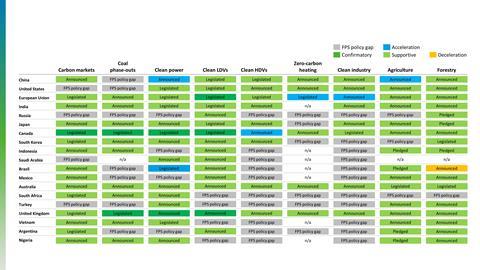Launched during COP27, IPR’s Policy Gap Analysis assesses progress to date against the Inevitable Policy Response scenarios in the years preceding the 2025 ratchet. It builds upon 2022 Quarterly Forecast Trackers and provides a sector by sector assessment of policy developments across the G20+ economies. Progress is assessed against the IPR 1.8°C Forecast Policy Scenario, a high-conviction policy-based forecast of forceful policy response and implications for energy, agriculture and land use where global emissions fall by 80% in 2050 to hold warming well below 2°C.
The analysis finds that the FPS 1.8C scenario, where policy ambition will be ratcheted up by 2025, is still in reach. Since the revised IPR policy scenarios were published a year ago, several significant policies have emerged that are largely supportive of the 1.8°C FPS trajectory, where policy announcements accelerate between 2023-2025 in advance of countries submitting the 3rd round of NDCs. Policy response is more delayed in non-OECD economies, reflecting rapid energy growth and later net zero targets.
While tracking momentum towards 1.8°C based on the IPR methodology, given the situation in the non-OECD, international climate policies and action are falling well short of 1.5°C RPS (no overshoot). IPR believes that currently it remains politically feasible to deliver on well below 2°C.
The IPR 1.5°C Required Policy Scenario (no overshoot), requires a massive acceleration in policy ambition particularly in the non-OECD. While technically feasible, no political pathway is currently evident that would deliver “1.5°C no overshoot”.
Policy developments supporting IPR 1.8°C FPS across G20+ economies

1. Based on major announcements and developments tracked in IPR 2021 Policy Forecast Detailed resource (March 2021) and 2022 QFTs: here.
Notes: Countries/regions ranked by current emissions (EDGAR, IEA). n/a indicates sectoral policy forecast not relevant to regional forecast (e.g. for zero-carbon heating, space heating less relevant in certain jurisdictions). See slides 21-28 for a detailed sector-by-sector assessment. While this table focuses on policy developments, IPR scenarios also account for technology and economic drivers of low-carbon technology uptake and behaviour change.
Webinar:
PRI COP27 Investor Event with IPR: Live from Sharm El-Sheikh
Downloads
IPR QFT Gap Analysis 2022
PDF, Size 1.22 mb












